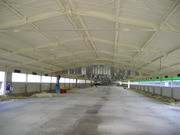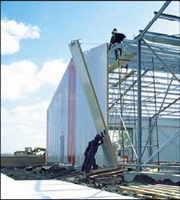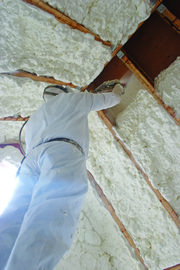Thermal insulation for construction
The use of polyurethane obtains the best thermal insulation. Below are the reasons:
High insulation capability: As stated, PU foam has the most efficient thermal insulation capability thanks to its low thermal conductivity. This characteristic is a result of the foam’s spatial construction built of small closed cells. This structure does not change over time hence the characteristic of the insulation is kept for many years, resulting also in big energy saving for a long period.
Many years of proven experience: For more than 30 years, PU foam has been proven as the best insulation material in Israel and worldwide. This experience was accompanied by researches and development for continuous improvement.
Low water absorption: PU foam is characterized by a very high percentage of closed cells. This feature provides the foam with both the capability of good thermal insulation and also very low water absorption that does not change over time. The low water absorption ensures the efficiency and quality of the thermal insulation also when exposed to humidity and water. Evidence for this ability can be seen in military uses, where polyurethane gives floating ability to heavy utensils/vehicles over water.
Sustained performance and longevity: When PU foam is protected and not exposed to the sun, it is resistant to wearing and can function without changes to its quality over a long period of time. Compared to other insulation materials, polyurethane does neither “surf” nor change its dimensions over the years.
Insulation continuity: The insulation shell obtained with polyurethane is continuous with no breaks and gaps, which prevents the creation of “thermal bridges” (cold bridges) and helps the uniformity of insulation, thus preventing the condensation in those vulnerable points. This is in contrast to the method of insulation by panels, where these gaps can evidently not be prevented, with all that implied.
Fast implementation: Sprayed PU foam is applied rapidly at hundreds and thousands of square meters each working day, which is evident in considerable financial savings.
Flexibility in implementation: Sprayed PU foam can be applied on flat or curved walls, so as filling gaps between double walls, between walls and the covering layer of the building etc. The flexibility of application also allows the spraying of insulation for pipes and other complex systems.
Mechanical strength: Sprayed PU foam has good mechanical strength both to pressure and stretch. This allows implementing the final coating advisable on walls and roofs, provided the application is implemented according to the specifications and requirements.
Small layer thickness: Thanks to the excellent thermal insulation qualities of polyurethane, it can be used in small layers, saving in the thickness of the wall and hence creating more space for the residential use.
Fire Safety: PU foam produced by Polyurethane Ltd. complies with the fire classification (B2.1.3 according toת”י 755) similar, and even exceeds other polymer insulation foams (!) classifications. It is suitable for all fire safety requirements defined in the Israeli standard 921 that relates to the thermal insulation foams.
Environment: The energy saved thanks to the efficient and continuous thermal insulation of PU foam exceeds dozens of times the energy needed to produce it. It is thus contributing to the savings of energy, reducing the use of polluting fuels and preserving the quality of the environment.
The demand for thermal PU insulation is ever growing worldwide, especially in the developed countries as it is understood that efficient thermal insulation allows considerable savings in natural resources, in the pollution of the environment and the financial expenses over the years.
For the insulation of building, mainly rigid polyurethane of the IN series is sprayed and within seconds from its application swells to 25 times its liquid volume. The spraying method allows the most effective and economic continuous insulation, preventing thermal bridges (cold bridges), contributing to the sealing and prevention of condensation.
Combining the aforementioned features provides the most efficient insulation material, which is also the most economic. The use of polyurethane includes, amongst others:
Insulation of walls, roofs and floors (see specifications).
Renovating existing homes.
Insulating roofs of industrial buildings. It is important to note that there is a reduction in the dangers caused by asbestos roofs, since polyurethane sticks to the roof and therefore creates a barrier between the asbestos and the people.
Insulation of chicken coups and agricultural constructions.
Insulation of cold stores, packaging stores.
Insulation of food trucks.
Insulation of household and commercial refrigerators, picnic boxes and more.
Insulation of water heating and solar energy systems (water boiler and sun collectors).
Thermal features of standard building materials (based on Israeli standard number 1045)
Material Maximal weight (kg/m³)
Thermal conductivity specific calculation W/mºC* (λ)
Concrete 2400 2.10
Aerated concrete 500 0.16
Glass/Rock wool > 25 0.16
Foamed polystyrene 15-30 0.04
Rigid PU foam > 27 0.03
Sprayed PU foam > 27 0.03
Thermal plaster 400 0.115
Raised Perlite < 100 0.06
* The calculated conductivity is the value used for the calculation of the thermal insulation features according to the establishment of standards and takes into account the water content in the material during its practical use.
Comparison of the insulation ability of the standard building materials (heat conductivity data according to Israeli standard number 1045)
It needs to be mentioned that the tested thermal conductivity values of the foam produced by Polyurethane Ltd. are even lower than the value used for the standard calculation, as can be seen below in the test results carried out by the laboratories of Bayer AG, the world leader in the PU market. Following are the test results (PU sample marked with LEU-2147-SH9-5):
Comparison of the insulation ability of the standard building materials (thermal conductivity results according to laboratory tests carried our by Bayer AG
Illustration of insulation activity on existing building
Below are pictures taken with an infra-red camera. In effect, this photography is carried out according to heat of objects in the area (similar to military and civil systems for night vision). Hot objects are those that emit a lot of heat to the environment and appear in the “warm” colors (on the upper edge of the scale to the right of each picture): red, orange and yellow.
Cold objects emit little heat to the environment and appear in the “cold” colors: dark blue, light blue and green. The pictures were taken on the same day, in the same environment and the same camera.
.
The house insulated with effective PU insulation of the IN series does not emit heat from the insulated areas. Only through the windows (in red) escapes heat but not through the building walls (in green/blue). In other words, the heat stays inside the house and is not being emitted to the cold environment outside the building. The house without PU insulation emits a lot of heat (energy) through its walls, more than through the windows. The waste is huge and so are the heating bills.
PU insulation foams of the IN series are produced by Polyurethane Ltd., owner of knowledge agreements with the German concern Bayer AG, for manufacturing and selling PU systems. The foams have been successfully applied for some decades around the world for different applications: spraying of residential housing, casting/pouring of elements for the insulation of cold store, spraying of agricultural constructions, casting of refrigerators, picnic boxes and many more.
 |
 |
 |

